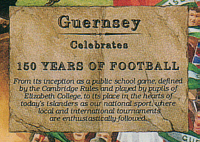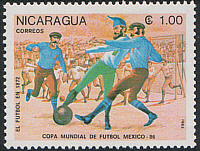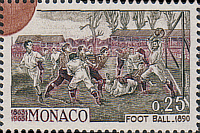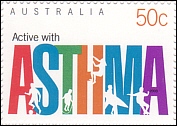|
|
|
History of
Soccer |
| The major
changes in Folk Football occurred in the schools and Universities. The value of
sport in children's upbringing was becoming popular and was fostered by "Tom
Brown's School Days". Each school or institution had their own set of rules
which often changed depending on the circumstances and a person of today would
hardly recognise the games as soccer or rugby. In 1823 at Rugby school William
Webb Ellis (or some other student) gasped the ball and ran with it, however the
first set of rules at Rugby School date from 1843. Eton school had preceded them
by 2 years. In 1837 Cambridge University decided on a set of rules which
disallowed handling of the ball. Generally it is thought
that the Cambridge rules led to soccer and the Rugby/Eaton rules to rugby,
however the reality was that their was much comprise locally. |
The plague at right is from a Guernsey
Minature Sheet celebrating 150 years of
football on the Island. It shows a stamp of England winning the World Cup in
1966 and of FIFA President from 1921-1954, Jules Rimet.
A
1 cor denomination stamp
(Sc 1398, SG 2643) issued by Nicaragua for
the 1986 World Cup, showed football in England in1846. |
 |
|
In 1848 former students of Cambridge University tried to find a
common denominator for the various rules. This was unsuccessful. By the late
1850's several clubs had been formed which favoured the kicking game. This
included Eaton and Harrow Schools, and Sheffield (1857) and Hallam (1859) who
played the first interclub match (under the Sheffield Rules) in 1860. Meetings
at Cambridge again tried to unite the games, but again they were unsuccessful.
This led to the Formation of the Football Association in 1863 comprising 11
clubs. The name soccer comes from the middlepart of the word association. |
 |
The triangular stamp at left, issued by Monaco (SG 774) shows
Wembley Stadium and commemorates the
100th Anniversary of the Football Association.
In 1865 the first overseas club joined, being Argentinean Club,
Buenos Aires FC and in 1867 the first Scottish Club joined. In 1870 the FA
banned the handling of the ball by any player except the Goal Keeper. This meant
the two codes were now reconcilably different and there was no going back.
In the first club competition "The FA Cup" was commenced and
the first international between
Scotland and England occurred.
|
|
| A
1 cor denomination stamp (Sc 1397,
SG 2642) shown at right was issued by Nicaragua for the 1986 World Cup, It
showed football in England in1872. Sharjah and
Dependencies issued a set of 7 stamps to celebrate the 1966 World Cup.
They were issued in blocks of four both perforate and imperforate.
The
1/2r denomination stamp
(SG 246) shows a match at Kennington Oval
in 1879. Kennington Oval, or the Oval, as it is more commonly known, is more
famous for the Surrey Cricket Club and test matches. It is |
 |
|
| where
the AFL plays it overseas Exhibition Games when in London.
A
2 cor denomination stamp
(Sc 1399, SG 2644) was issued by Nicaragua for the 1986
World Cup, It showed football in England in1883. |
 |
Both Monaco (SG 781) ( stamp shown at left) and Nicaragua
issued part of a painting of a soccer game in 1890 by Owerend. The Nicaraguan
stamp, a
4 cor denomination stamp
(Sc 1400, SG 2645) was issued to commemorate the 1986
World Cup,
FIFA, the Fédération
Internationale de Football Association was formed in 1904. |
|
This international football community grew steadily, although it sometimes met
with obstacles and setbacks, notably the withdrawal of the UK over the inclusion
of Germany. In 1912, 21 national associations were already affiliated to FIFA.
By 1925, the number had increased to 36, in 1930 - the year of the first World
Cup - it was 41, in 1938, 51 and in 1950, after the interval caused by the
Second World War, the number had reached 73. At present, after the 2000 Ordinary
FIFA Congress, FIFA had 204 members in every part of the world.
The first World Cup was held in Uruguay in 1930 and was also
won by the host nation. Australia played in the 1974 World Cup in Germany. After
the 2002 World Cup FIFA decided that the winner of the Oceania group will
have direct access to the 2006 World Cup.
|
|
|
Australia
1 Stamps
Australia has issued 2 stamps commemorating soccer. The stamp above at right is
part of the 1989 Sports Definitive Issue. It included a
FDC.
and
Maximum Card.
It was issued on the 22nd August 1991. The stamp above left is part of the issue
for the
1976 XXI Olympic Games
in Montreal.
|
 |
On the 14th October
2003 Australia issued a 50c stamp to encourage exercise in patients with asthma.
It showed five types of exercise, soccer, skipping, climbing, surfing
and skateboarding.
The maximum card and FDC showed swimming.
The soccer player (enlarged at right) is depicted in the lower left hand corner
of the stamp. (at left) |
 |
|
|
2.Covers
A
PSE was issued on the 14th January 1993
for the VII World Youth Championships for the FIFA Coca-Cola Cup.
3. Postmarks
|
|
Number** |
Date Issue |
Postmark |
Post Office |
P'code |
|
APM1174 |
22/10/56 |
1956 Melbourne
Olympics |
Melbourne |
|
|
APM21052
|
13/2/89 |
1989 Sports Issue
FDC |
Sydney |
2000 |
|
APM22146
|
13/4/90 to 16/4/90 |
4th Suncorp Nth Qld Games in which soccer was
played |
Mackay |
4740 |
|
APM23690 |
22/8/91 |
Sports Series III |
Parramatta |
2150 |
APM25160
APM25161 |
14/1/93 |
World Youth Soccer
Championship |
Sydney
Philatelic Bureau |
2000 |
|
APM33140 |
13/9/00- |
Hindmarsh Stadium
Olympic Soccer |
Hindmarsh |
5007 |
|
APM33221 |
15/9/00-1/10/00 |
2000 Sydney
Olympics |
Sydney |
2000 |
|
4. Personalised Stamps
Boxing Kangaroo Booklet
issued on 13/8/2004
with label showing
Kangaroo playing Soccer.
Sydney 2000 Olympic Soccer
The 2000 Olympic Soccer tournament was the only
Olympic sport that was also held outside Sydney. Matches were played at Stadium
Australia, the Sydney Football Stadium, the MCG (covers of
Chile v Morocco and
USA v China), the Gabba in
Brisbane (cover of
Brazil v Slovakia), the Bruce
Stadium in Canberra and the Hindmarsh Stadium in Adelaide (covers of
Spain v Korea and
Nigeria v Honduras).
The men's competition has 16 sides and the majority of the
players must be under 23. The competition was won by Cameroon with Spain winning
the silver and Chile the Bronze.
The women's competition has 8 sides and players must be over
16. Norway won the Gold from the USA and Germany took the Bronze.
Soccer Philately is by far the largest branch of Football
Philately. It is the most popular code and together with the World Cup and the
Olympics there is a wealth of collecting material. Please visit the websites in
the panel on the right especially the
Soccer Stamps site. |
|
|
|
|